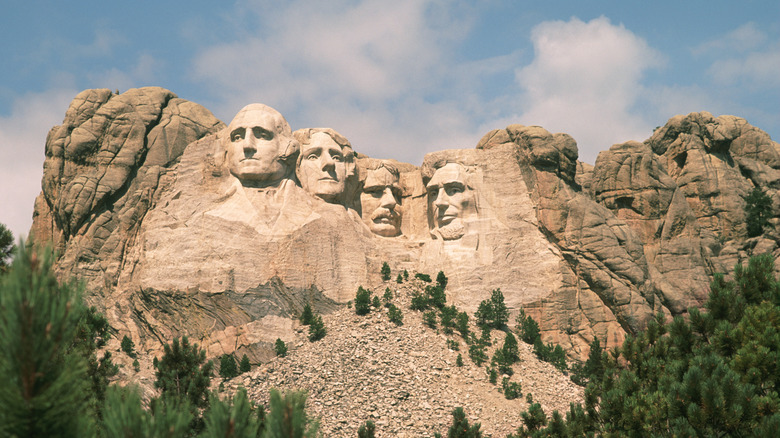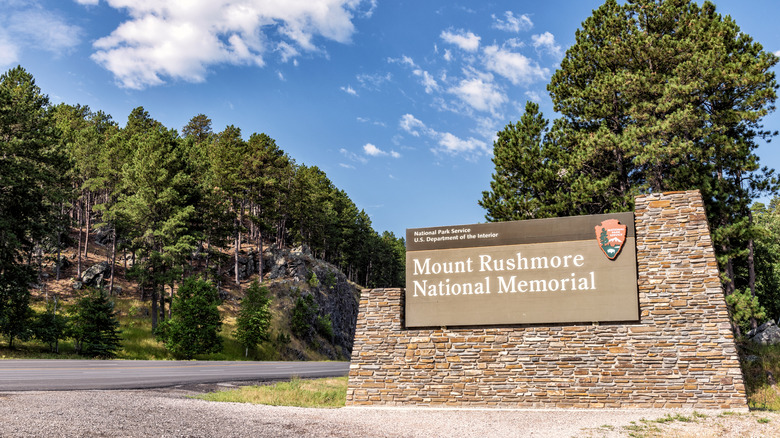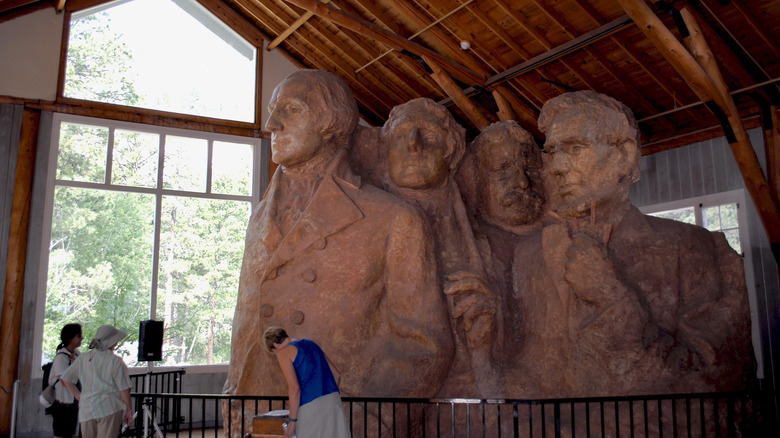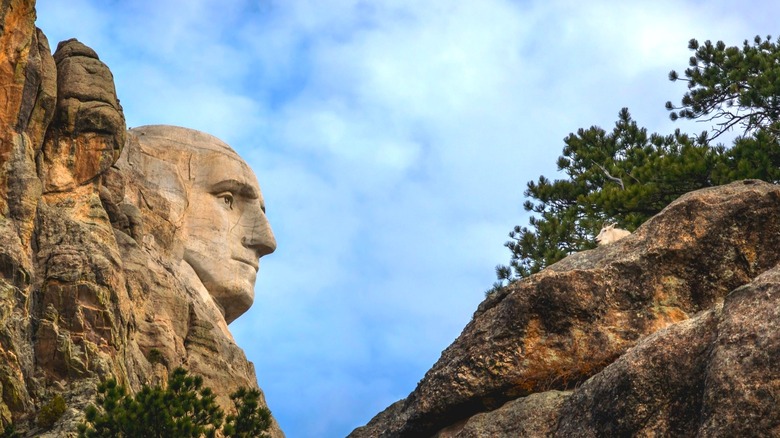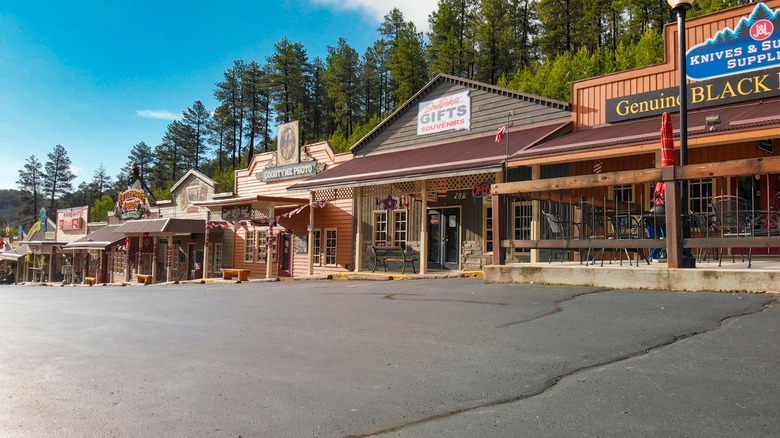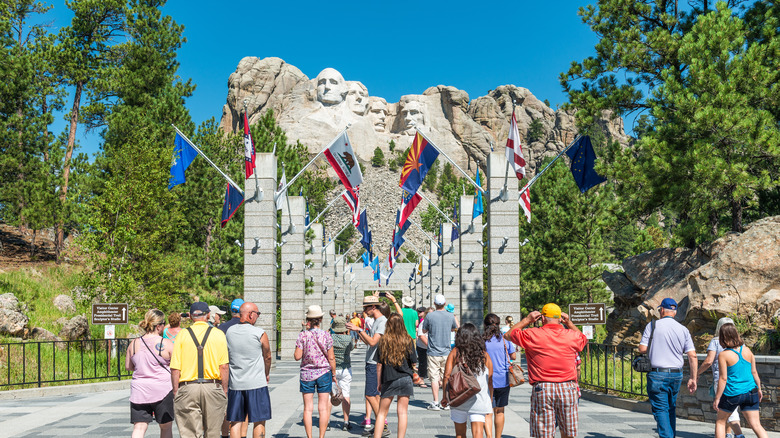What To Know Before Visiting Mount Rushmore
Located in the Black Hills of South Dakota, Mount Rushmore is one of America's most iconic landmarks. In fact, it is the most-visited tourist attraction in the state. It's an unforgettable sight — the colossal 60-foot-tall granite faces of four U.S. presidents carved into a mountainside. But before you pack your bags and head to see George Washington, Thomas Jefferson, Theodore Roosevelt, and Abraham Lincoln in monumental glory, some preparation is in order.
In this definitive guide to Mount Rushmore National Park, you'll unravel the stories behind its creation and get all the essential visitor information. Discover the park's unique offerings, from the evening lighting ceremony to exclusive tours of the sculptor's workshop, home to a near-century-old scale model. Delve into the history and wildlife of the Black Hills while also understanding its profound significance to Indigenous communities. Find recommendations on dining, accommodations, and the park's elusive secret room.
Costing nearly $1 million dollars, Mount Rushmore took 14 years to complete, with work starting in 1927 and finishing in 1941. The sculptor behind the grand project was Gutzon Borglum, assisted by his son, Lincoln Borglum, and a team of nearly 400 workers. The original intention was to promote tourism in the state with a jaw-dropping drive-by attraction, and it certainly worked — over 2 million visitors flock to the site each year. "The purpose of the memorial is to communicate the founding, expansion, preservation, and unification of the United States," explained Gutzon Borglum (via the National Park Service). It was supposed to represent a "Shrine of Democracy."
When and how to visit Mount Rushmore
The National Park Service designated Mount Rushmore under its jurisdiction in 1933. Since then, the site has been open to visitors year-round and has become a symbol of America. The best time to visit for warmer weather and the park's full range of services is between May and October. The busiest months are June, July, and August, so if you prefer fewer crowds, consider visiting outside this time frame — or arriving early, as Mount Rushmore is quietest before noon. While the parking area and surrounding grounds open at 5 a.m., the visitor center doesn't start welcoming guests until 8 a.m. Note that the weather in the Black Hills can sometimes be unpredictable — even in the summer, temperatures can drop in the evening. Dress in layers, wear comfortable shoes, and depending on when you're visiting, bring a rain jacket just in case.
While there's no entrance fee for Mount Rushmore, there is a parking fee of $10 per vehicle. The parking pass is valid for the entire calendar year so that you can return multiple times without any additional charges — however, overnight parking is not allowed. If you have a National Park pass, it unfortunately won't cover that parking fee, as the facility is operated by a third party. There is also ADA-accessible parking, and wheelchair rentals are available at the Information Center. Most facilities at Mount Rushmore — including the Grand View Terrace and the main pathways — are wheelchair accessible.
Programs, activities, trails, and more
Mount Rushmore National Memorial offers various ranger-led programs that provide deeper insight into the monument, presidents, and carving process. These programs are informative and engaging, making them ideal for both children and adults. There is also an evening lighting ceremony — one of the most mesmerizing experiences at Mount Rushmore. Held from late May to late September (at 9 p.m. in May through early August and 8 p.m. in early August through September), this event illuminates the monument and provides a touching tribute to U.S. veterans. Check the event calendar in advance or upon arrival, as programs vary seasonally. No reservations are required to participate in any of the programs at Mount Rushmore, but activities are weather-dependent.
Apart from marveling at the monument, Mount Rushmore also offers a Presidential Trail, an accessible half-mile loop that gives you closer views of the sculptures. The Lincoln Borglum Visitor Center showcases interactive exhibits that delve into the monument's history, including a film — "Mount Rushmore: The Shrine" — depicting rare footage from the carving days. The Sculptor's Studio displays authentic tools, small-scale models, and sketches, illuminating the step-by-step process employed by Gutzon Borglum and his team. One of the studio's highlights is a 1/12th scale model of the mountain, which Borglum used to guide the dynamite blasts and chiseling on the mountain. Dynamite was used for 90% of the sculpting process, and contrary to popular belief, no one died during the process.
The sacred nature of the Black Hills
Mount Rushmore is unfortunately involved in some controversy. Before it was known as Mount Rushmore, the raw granite formation in the Black Hills was called Tunkasila Sakpe Paha, or Six Grandfathers Mountain. The memorial was built on sacred Native American land that was taken illegally by the U.S. government, violating an 1868 treaty that granted the Black Hills to the Lakota Sioux in perpetuity. Since then, there has been a continued dispute regarding the monument's location, financial settlement, and a return of the land.
It's crucial to maintain the integrity of the monument and the Black Hills landscape while recognizing the cultural significance of the area for its Indigenous inhabitants. Stay on marked paths, avoid littering, and be respectful — leave no trace. If you wish to learn more, the Lakota, Nakota, and Dakota Heritage Village — located within the Mount Rushmore National Park — welcomes visitors to gain a better understanding of the history, culture, and traditions of local Native American people.
The Black Hills land is a bustling ecosystem teeming with wildlife — Mount Rushmore is only a small 1,300-acre bit of it. While enjoying the expansive mountain views, watch for mountain goats often seen on the granite outcroppings around the sculpture. You may also witness yellow-bellied marmots, Cooper's hawks, and the Black Hills redbelly snake, which can be found nowhere else in the world except here. If you feel like venturing further into the land, try the 1-mile-long Blackberry Trail or the connecting Centennial Trail.
Keystone and beyond: Where to eat, stay, and explore
While Mount Rushmore is the star, the surrounding region boasts many attractions worth a visit. Check out Badlands National Park, Jewel Cave National Monument, and Wind Cave National Park for more natural exploration opportunities. A 30-minute drive from Mount Rushmore stands Crazy Horse Memorial, which depicts the leader of the Oglala Sioux (it is still under construction). Once completed, it will be the world's largest mountain carving.
The area surrounding Mount Rushmore offers a range of accommodations, from campgrounds to hotels. Keystone, a nearby town, is the closest hub for lodging. If you have an RV, Mount Rushmore Resort & Lodge at Palmer Gulch is considered one of the top RV parks in America with the most amenities. For those seeking a more intimate overnight setting, Battle Creek Lodge is a delightful B&B option. For the adventurous, Black Hills National Forest has 682 campsites available for rent. Book in advance — especially during peak season — to secure your preferred choice.
While there are plenty of restaurants in nearby towns, if you're looking for a bite to eat closer to the monument, the Carvers' Café is your best bet. It offers a variety of options, from the monumental special ($10.75) to chicken Caesar salad ($10) and bison burger ($12). To savor a sweet treat concocted by one of the presidents chiseled into the mountainside, try Thomas Jefferson's original ice cream recipe next door at Memorial Team Ice Cream!
Maximizing your Mount Rushmore visit
While the monument itself can be viewed in a short time, to fully appreciate everything Mount Rushmore and its surroundings have to offer, plan to spend at least half a day. This will allow time for walking trails, ranger programs, exploring the visitor center, and enjoying a tasty meal. To bring a piece of Mount Rushmore home with you, the gift shop offers a range of souvenirs to commemorate your visit. Purchases here support the ongoing preservation and educational efforts of the monument.
People often wonder if it's possible to actually go inside Mount Rushmore. The letdown answer is: No, you cannot go inside the heads because they are carved directly into the mountain. There once was a plan to build tunnels through the faces, but it was scrapped in 1939 due to a lack of financing. However, inside the mountain, where Abraham Lincoln's brain would be, is an inaccessible Hall of Records (a secret room, if you will). It contains a repository of 16 porcelain enamel panels inscribed with information about Mount Rushmore and U.S. history, left as a human record for anyone who stumbles upon it eons from now.
Visiting Mount Rushmore is one of those things every American should do in the U.S. in their lifetime. With the right preparation, knowledge, and respect, your trip to this ubiquitous American landmark will be memorable and meaningful. But hurry! The sculpture's rate of erosion is approximately 1 inch every 10,000 years — which means it'll be around for a very, very long time.
